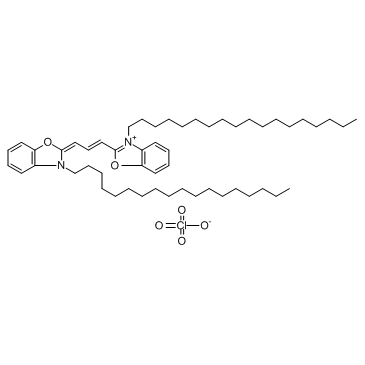3,3'-Dioctadecyloxacarbocyanine perchlorate

3,3'-Dioctadecyloxacarbocyanine perchlorate structure
|
Common Name | 3,3'-Dioctadecyloxacarbocyanine perchlorate | ||
|---|---|---|---|---|
| CAS Number | 34215-57-1 | Molecular Weight | 881.70500 | |
| Density | N/A | Boiling Point | N/A | |
| Molecular Formula | C53H85ClN2O6 | Melting Point | N/A | |
| MSDS | Chinese USA | Flash Point | N/A | |
| Symbol |

GHS07 |
Signal Word | Warning | |
|
Assembly of multiple cell gradients directed by three-dimensional microfluidic channels.
Lab Chip 15 , 3203-10, (2015) Active control over the cell gradient is essential for understanding biological systems and the reconstitution of the functionality of many types of tissues, particularly for organ-on-a-chip. Here, we propose a three-dimensional (3D) microfluidic strategy for... |
|
|
Polysaccharide-K augments docetaxel-induced tumor suppression and antitumor immune response in an immunocompetent murine model of human prostate cancer.
Int. J. Oncol. 40(4) , 905-13, (2012) Advanced castration-resistant prostate cancer has high mortality rates and limited treatment options. Novel therapies are needed to better contend with this disease. Polysaccharide-K® (PSK), an extract of the mushroom Trametes versicolor, has immunomodulatory... |
|
|
Cell selective chitosan microparticles as injectable cell carriers for tissue regeneration.
Biomaterials 43 , 23-31, (2015) The detection, isolation and sorting of cells holds an important role in cell therapy and regenerative medicine. Also, injectable systems have been explored for tissue regeneration in vivo, because it allows repairing complex shaped tissue defects through min... |
|
|
Improving the efficacy of therapeutic angiogenesis by UTMD-mediated Ang-1 gene delivery to the infarcted myocardium.
Int. J. Mol. Med. 36 , 335-44, (2015) This study aimed to verify the feasibility and efficacy of ultrasound-targeted microbubble destruction (UTMD)-mediated angiopoietin-1 (Ang-1) gene delivery into the infarcted myocardium. Microbubbles carrying anti-intercellular adhesion molecule-1 (ICAM-1) an... |
|
|
Role of the phospholipase A2 receptor in liposome drug delivery in prostate cancer cells.
Mol. Pharm. 11(10) , 3443-51, (2014) The M-type phospholipase A2 receptor (PLA2R1) is a member of the C-type lectin superfamily and can internalize secreted phospholipase A2 (sPLA2) via endocytosis in non-cancer cells. sPLA2 itself was recently shown to be overexpressed in prostate tumors and to... |
|
|
Nanoparticle-mediated delivery of the antimicrobial peptide plectasin against Staphylococcus aureus in infected epithelial cells.
Eur. J. Pharm. Biopharm. 92 , 65-73, (2015) A number of pathogenic bacterial strains, such as Staphylococcus aureus, are difficult to kill with conventional antibiotics due to intracellular persistence in host airway epithelium. Designing drug delivery systems to deliver potent antimicrobial peptides (... |
|
|
In Vitro and In Vivo Efficacy of Self-Assembling RGD Peptide Amphiphiles for Targeted Delivery of Paclitaxel.
Pharm. Res. 32 , 3087-101, (2015) The objective of this work was to compare the efficacy of self-assembling cyclic and linear RGD peptide amphiphiles as carriers for delivering paclitaxel to αvβ3 integrin overexpressing tumors.Linear (C18-ADA5-RGD) and cyclic (C18-ADA5-cRGDfK) peptide amphiph... |
|
|
Controllable organization and high throughput production of recoverable 3D tumors using pneumatic microfluidics.
Lab Chip 15(4) , 1195-204, (2015) Three-dimensional tumor culture methods offer a high degree of biological and clinical relevance to in vitro models as well as cancer therapy. However, a straightforward, dynamic, and high-throughput method for micro-manipulation of 3D tumors is not yet well ... |
|
|
Glioblastoma exosomes and IGF-1R/AS-ODN are immunogenic stimuli in a translational research immunotherapy paradigm.
Cancer Immunol. Immunother. 64(3) , 299-309, (2015) Glioblastomas are primary intracranial tumors for which there is no cure. Patients receiving standard of care, chemotherapy and irradiation, survive approximately 15 months prompting studies of alternative therapies including vaccination. In a pilot study, a ... |
|
|
Enhancement of osteoclastogenic activity in osteolytic prostate cancer cells by physical contact with osteoblasts.
Br. J. Cancer 104 , 505-13, (2011) The interaction between prostate cancer cells and osteoblasts is critical for the development of bone metastasis. Metastatic cancer cells may physically contact osteoblasts in the bone microenvironment; however, the biological significance of this interaction... |